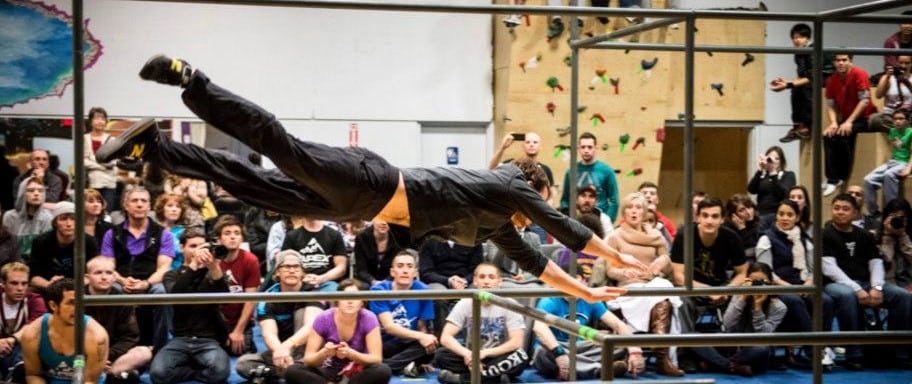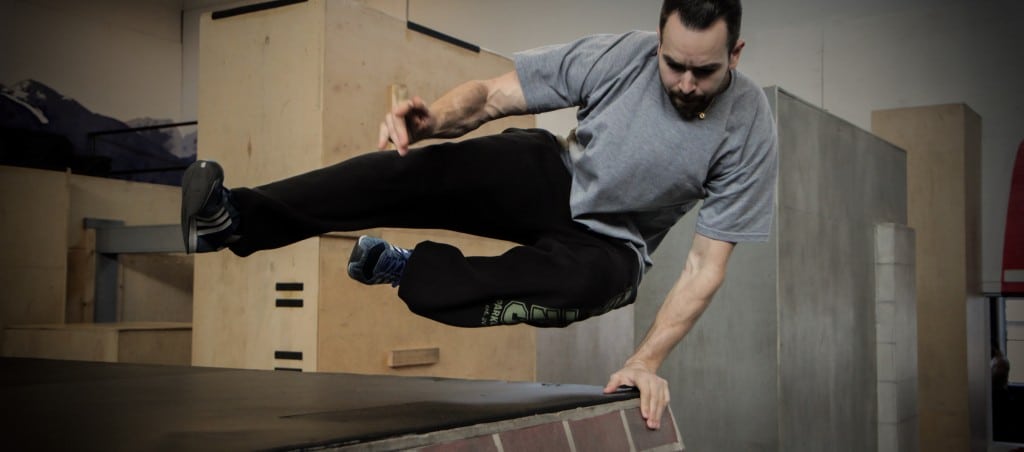Standard Disclaimer: The following program is designed for athletes. If you train only 1-3 times per week this is going to sound like a lot and might not be for you. Having said that, this could be the perfect template to bring organization to your training, get you out more, and up your overall game.

Two Additional Programs
1 – Explosive Power Block
Once general strength has peaked you can switch your focus to improving jumping power. Strength training alone can have positive effects on jumping power, but workouts focused solely on primary movements and maximal jump exercises will really start to bridge the gap between general strength and parkour performance. In this block we will look at a method that took me years to finally get right!
2 – In-Season Strength Recommendations
You can still lift weights when you are focusing on having the best parkour sessions. In my almost two decades of parkour exploration I have always struggled with finding a balance of parkour performance and general preparation year round. I admittedly did way too much general preparation for a time. As a result my technical, and especially my mental development, didn’t see much progress. In other years I completely scrapped general work and only focused on the mental and technical side of things, but this resulted in decreased power in my jumps. In this section I will break down how to continue working on general preparation without burning yourself out.
NOTES:
Foundation Block Intensity
After running athletes (and myself as always) through the foundation block into a maximal strength block a number of times I found that the loads were too low. So now the loads represented are about 10% higher, with respective rep/sets adjusted.
For all of your primary movements I recommend using the lower end of the percentages given on your first week. Unless of course you have been lifting frequently in the Summer, and your body is acclimatized to heavier weights.
Upper Body Primary Movement
In the foundation phase you will build up two, separate primary upper body movements. You will continue to build up just one of these in the strength block. Upper Body increases in strength tend to happen slower than they do for the lower body. Use the Foundation block to get a head start with more volume (higher sets/reps) with whatever percentage allows it. When you repeat the same set/rep/percentage schemes in the Strength Block you can switch to lower volume recommendations and higher percentage recommendations.
Condensed Strength Block
In my former edition there were two options for the strength block to run for 6 weeks or 11 weeks. The newly added intensity in the Foundation Block will already add 4 weeks of build up, so the strength block will revert to a standard 6 week stage. It is not a guarantee that you will reach or exceed a previous personal best in six weeks. This all depends on what you are doing for the rest of the year. You can also take 12 weeks and do the program twice depending on your goals. If you decide ahead of time to do two strength cycles I recommend doing the first cycle using low percentages and high volume, and the second cycle using high percentages and low volume.
Set Yourself Up for Success
I receive a number of messages from people claiming their first week is too hard. Ninety nine percent of the time this is due to the person using way too much weight on their primary movement. If you are failing lifts on week one it is likely, because you have made a mathematical error or an overestimation of your 1RM. Here are a couple of ways to avoid overdoing it.
- Use 90% of a previous 1RM as your 100%. If you have not performed anything close to your previous personal best recently, then it is probably no longer your 100%. Rather than retesting simply take 90% of your previous best and use that new number to calculate all of your other percentages off of.
- Example: If your best squat is 225lbs, but you haven’t lifted anywhere near that much in months, take 90% of 225 and round it as you please = 202.5 or 205lbs. Now Week 1 of the program calls for 70-75%, so you’re lifting somewhere in the range of 145lbs to 155lbs.
- Do the lowest possible percentage and the lowest possible volume for your work sets in the first couple of weeks.
- Example: Strength Block Wk 1 = 75-80% for 4 or 5 sets of 5. So you would do 4×5 at 75%. If it’s really easy you can always do a bonus set of 5.
If you are failing reps of your primary movement on the very first week of a ‘block’ you need to restart that block with more attainable weights. If you continue on in the program you will not see any improvements by the end of it.
FOUNDATION BLOCK
The Foundation Block is 3 weeks long, plus one “deload” week. The purpose is to build up work capacity and technique in each movement. The primary lower body movements in this phase are unilateral to emphasize improvements in joint stability before we jump into bilateral lifts where greater outputs will be produced.

Primary Lifts
Primary Lifts will happen in every workout, sometimes after some initial dynamic/elastic drills. At the top of the program you will find a table labeled “Primary Lifts Progression”. This is where you will go to find the sets and repetitions you will do for the primary movement. The first thing you’ll notice is that I do not give a precise number; instead there is a range of repetitions, and an amount of total repetitions to shoot for. This allows the program to be modified for a broader range of people. For example: on week 1 you can do 5-6 reps per set, and 25-30 total reps, so acceptable formulas for reps/sets would be: 5×6, 6×5, or 5×5 (4×6 would also be acceptable even though it is one rep short of the minimum, but that can be our little secret 😉
The percentages on the chart are based off of existing “One Rep Maximum(s)”. You will notice the percentages increase in small increments each week. This is a simple progressive overload method that is tried and true for building strength in all levels of athletes. Notice that the percentages are also often proposed in a range, so you have some flexibility with the intensity you are working at. Feel free to interpret it how you will, but make sure to follow the slow incremental progress as outlined for best results.
Example Week 3.
| Reps Per Set | Total Reps | %1RM |
| 3 | 9-15 | 80-85% |
The percentage is 80-85, which means you could perform each set at a different weight, or all of them at the same weight. If you decide to perform 4 sets of 3 reps, your workout could look like Work-Up: 45% x 8-10, 55% x 6-8, 65% x 5 Work-Sets: 3×80%, 3×82%, 3×84%, 3×85%, or the work sets could simply be 4x3x80%, 4x3x82% or 4x3x85%. All of the above repetition and percentage schemes are acceptable. What’s most important is that the reps go up smooth.
Accessory Movements
Accessory exercises are performed after your primary lift. These exercises are done to increase strength and muscular hypertrophy. Try to take shorter rest periods between sets for these movements to also increase your work capacity. Make sure if you are taking shorter rest periods to account for this when choosing the weight you will work with.
I have only provided a range for total repetitions. This means there are a lot of different set/rep schemes that could work. As long as the rest periods are kept at a minimum it’s all pretty much the same. If the total repetitions you’re shooting for is 50 you could do 10×5 and feel very focused during each set, because you’re only doing 5 reps each time, or you could do 5×10, or 4×12-13, 3×15-17, etc. Stick to a set rep scheme for 2-3 weeks, and then change it up.
Parkour Skill Work
You still can and should do parkour outside of the prescribed strength and conditioning program. I recommend making a list of singular skills to work on during the off-season. You can also train lines and have haphazard sessions so long as you are monitoring and recording your intensity. You can use “RPE” (Rate of Perceived Exertion) to monitor intensity.
Try to keep most of your training below a 7 or an 8, and do not push the amount of repetitions you do. For example: If you are doing an effortful standing pre keep the reps low, so that the overall effort feels like a 7-8/10. If the standing pre is smaller you can do more reps, but the more you do the more you will increase your perceived exertion unless you are taking a lot of breaks. A good way to keep intensity lower is to do your parkour training after workouts. Even if it’s later in the day you will be noticeably fatigued and less likely to over do it. You can also fit in light parkour training on Off days.
In the schedule for each training block you will find the strength & conditioning schedule, as well as an example of a schedule that incorporates parkour training.
What happens if you overdo it in a session?
Maybe you get really inspired, you feel strong from all of the general strength work, and you set your eyes on a challenge you can’t resist. This challenge takes a number of attempts, and before you know it you’ve blown 15 attempts, nailed the challenge, but clearly this has been a 9 or 10 effort and you’ve outdone yourself. If this is the case you should skip a WORKOUT or at least skip the speed work and the primary movement. You need to recover to get stronger, so it’s counterproductive to do too much. Plus if you’re getting so much better that you are able to achieve new challenges, then the program is doing its job already. As long as you’re not missing workouts all the time everything should be fine.
If you have a really disorganized or stressful week and miss most of your workouts, I would recommend simply repeating the week.
Tempo Workouts, and Deloading
“Off” days are also marked as “Aerobic” and “Recovery” days. You could also do an Aerobic workout earlier in the day before a WORKOUT. Tempo workouts are the best type of aerobic and recovery training for speed/power athletes. I recommend trying to hit 2-3 tempo workouts in a week.
Tempo workouts are meant to be low intensity. Do not get tempo workouts confused with high intensity interval training. You should feel better at the end of the session than you did at the start. If you are breathing so heavy you can’t have a conversation you are working too hard and need to dial back the intensity. Investing in a heart rate monitor can make training in your aerobic zone more precise.
Tempo Sprints
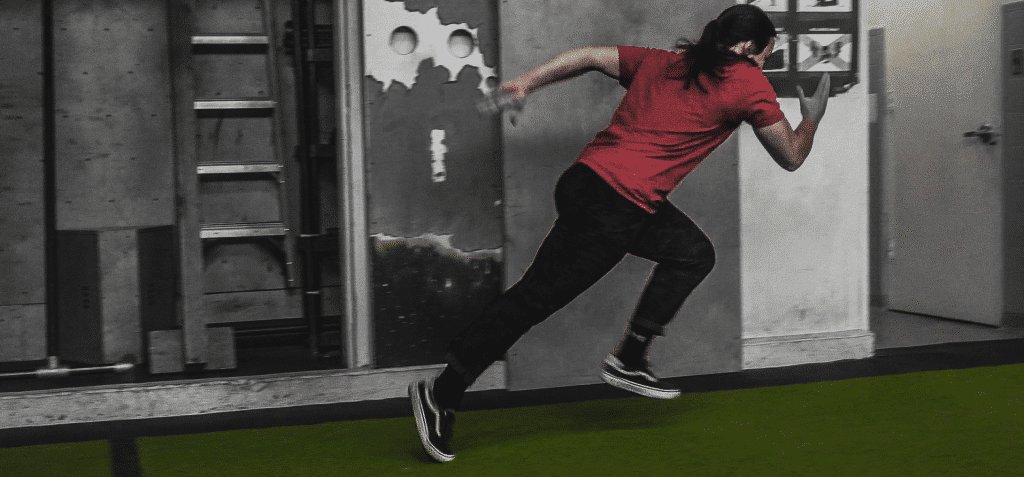
Aim for 8 to 14 total Sprints
- Sprint 100 meters at 70% intensity. (Should feel relaxed and easy)
- Walk Back.
- Add drill or exercise. I like to do all my tempo workouts by performing a drill or exercise at the end of the sprint before walking back. Examples: Push ups, sit up variations, physio exercises, isolation exercises with bands, single leg body-weight movements, etc.
Stationary Tempo
If you can’t get out to sprint you can still do tempo workouts with limited space. Instead of the 100m sprint you can simply do low intensity running-As, or ride a stationary bike for 30 seconds. Follow this up with a drill or exercise of your choosing, and then rest for 30 seconds. Again you’ll be aiming for in between 8-14 total rounds of this.
Deload Week
A *deload week is taken every 3-5 weeks. During the deload week you have two options: 1. Completely take the week off and just do a couple of tempo workouts to help promote blood flow and increase recovery.
- Do the same workout schedule, but in each workout do half of the amount of reps/sets you normally would. Avoid impact on your joints (less jumping/landing) and use less weight on the primary movements to “Deload” your spine. You will find lighter weight and fewer rep recommendations for primary movements on deload weeks.
Work-Up Sets
Work-up sets should be done for each primary movement. Work Up sets are a method used to stimulate your nervous system and prepare it to switch on more motor units for each following set. Also think of the work-up sets as more practice to improve your technique of the exercise, and more volume to stimulate muscular adaptation. Using work up sets not only makes lifting heavy weights safer, but you will also be more successful at performing your primary lifts. Here is a standard model you can follow:
45% x 8-10
55% x 6-8
65% x 5
As the weight gets heavier you can add in another Work-up set every 5-10%.
For example: Working weight = 85%x4. Perform above sets followed by 75%x4, 80% x4, etc. Rest between work-up sets should be 1-2 min.
Schedule
Monday – WORKOUT Ai
Tuesday – WORKOUT Bi
Wednesday – Off / Aerobic / Recovery
Thursday – WORKOUT Aii
Friday – WORKOUT Bii
Saturday – Off / Aerobic / Recovery
Sunday – Off / Aerobic / Recovery
Schedule + Parkour Workouts
Notice that most of the parkour drills occur after workouts or on the off days, and the more loosely defined “session” workout occurs on Saturday. By doing your PK skills after the strength & conditioning work you will likely be too fatigued to go too hard. For the same reason you could plan to have a looser and more challenge based session on Saturday at the end of a long week of training. Sunday could then be reserved for recovery.
Monday – WORKOUT Ai / PK Drills
Tuesday – WORKOUT Bi
Wednesday – Aerobic / PK Drills
Thursday – WORKOUT Aii / PK Drills
Friday – WORKOUT Bii
Saturday – Aerobic / PK Session
Sunday – Off / Aerobic / Recovery
NOTE: There is nothing wrong with having a week that starts on a different day. For example your week could be Tuesday to Monday instead of the traditional Monday to Sunday. Do what makes the most sense for your schedule and current commitments.
Primary Lifts Progression
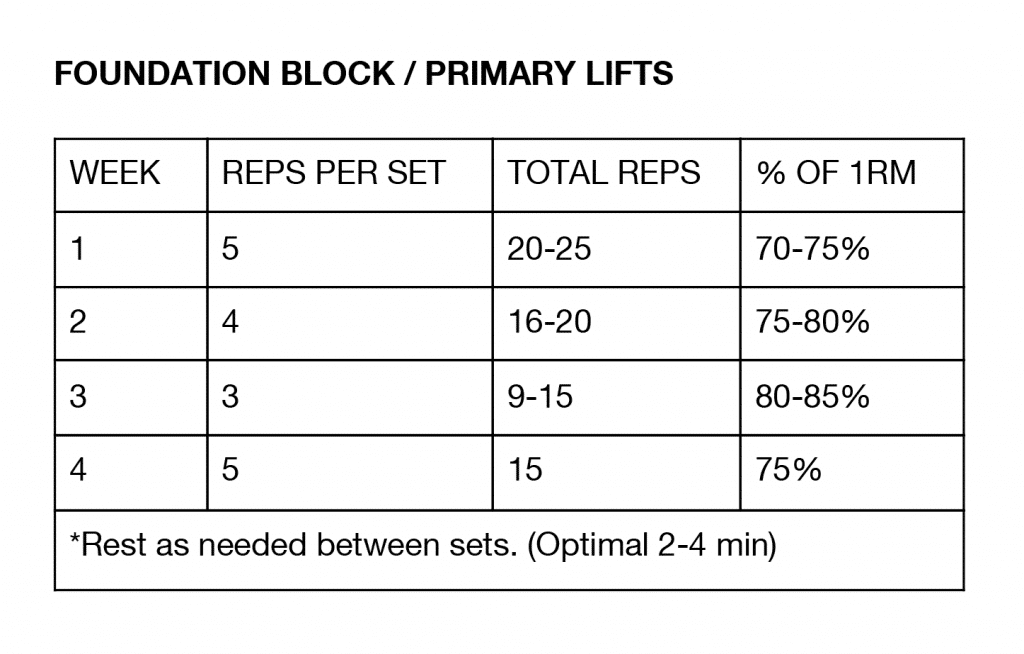
WORKOUT A – Sprints, Jumps, & Upper Body Weights
A. Sprinting Drills: Perform each of these 1-3 times for 20-40 repetitions before your sprints.
- A-March
- A-Skip
- Running-A
B. Sprinting Starts: Pick one of the following variations for a 10m Sprint and Perform 3-5 Sprints with 1 minute rest between them.
- Split-step start
- Push-Up Start
- 3 or 4 point start
C. Short Accelerations: Pick one of the following variations for a 20m Sprint and Perform 3-5 Sprints with 1-2 minutes rest between them. Choose a different variation than you did for B.
- Split-step start
- Push-Up Start
- 3 or 4 point start
D. Single Leg Bounds (Submaximal) – Perform 3-5 jumps per leg, for 3-4 sets. Rest as needed.
- Use a slight hill or plyo boxes (if available) to mix in jumping upwards
E. Upper Body Primary Movement – Pick one “Pressing” movement for Workout Ai, and one Pulling movement for Workout Aii.
Pressing (Ai)
- Bench Press
- Incline Bench Press
- Weighted Dips
- Military Press
Pulling (Aii)
- Weighted Chin-Ups
- Weighted Pull-Ups
- Barbell Rows
F. One Arm Movement – Pick one “Pulling” movement for Workout Ai, and one “Pressing” movement for Workout Aii. Do 40-60 total reps.
Pulling (Ai)
- One Arm DB Row
- One Arm Cable or Band Row
- One Arm Landmine Row
Pressing (Aii)
- DB Incline Press
- DB Bench Press
- Med Ball “One-Arm” Push-Ups
G. One for the Delts – Pick one of the following for 40-60 total reps.
- DB Lateral Raise
- L-lateral Raise
- Band or Cable Lateral Raise
- DB Military Press
H. Elbow Flexors / Extensors Superset – Don’t feel like listing all the possibilities, but pick two exercises and hit 12-20 reps of each for 3 sets.
- Bicep Curls
- Tricep Extensions
WORKOUT B – Dynos & Lower Body Weights
A. Dynamic Climbing Movement – Pick one of the following and perform 3-5 Reps, for 3-4 Sets.
- Dyno
- Climb-Up
- Cat-Back
B. Single Leg Movement: (see Primary Lifts Progression)
- Step-Ups
- Bulgarian Split Squats
- Reverse Lunge or Walking Lunges
- Single Leg Deadlift
C. Secondary Single Leg Movement. Pick one “Post-Chain” movement for Workout Bi, and one “Quadriceps” movement for Workout Bii. Do 30-50 total reps for each leg.
Post-Chain Movement (Bi)
- Swiss Ball Glute Bridge + Legs Curl + Single Leg Eccentric
- Swiss Ball Single Leg Glute Bridge + Leg Curl
- DB Single Leg Deadlift
Quadriceps Movement (Bii)
- DB Reverse Lunge
- DB Bulgarian Split Squats
- DB Step Ups
D. Weighted Abdominal Movement – Pick one and hit 30-40 total reps.
- Leg Raises
- Ab Wheel
- Weighted Sit-Ups
E. Gastrocnemius / Calves Movement – Pick one and hit 40-60 total reps.
- Single Leg Calf Raises
- Weighted Calf Raises
- Weighted Seated Calf Raises
Finding 1RM for Single Leg Movements.
- If you already have a PB for your squat you can simply divide it by two and use that as your single leg strength maximum. This should make most of the recommended percentages feel super easy. Example: Squat PB of 345lbs / 2 = 172.5 lbs
(I know for a fact my Bulgarian Split Squat is significantly more than half of my squat, but I don’t have a reliable way of calculating it.)
- Perform a 5RM on your first workout, and use this equation to calculate your 1RM.
Example: 5x185lbs [ Weight(185) x Reps(5) x 0.0333 ] + Weight(185) = 215lbs 1RM.
Calculating for Weighted Pull/Chin-Ups
This one only gets weird if you’re not very strong. If you have a weighted pull with at least half of your body weight attached to you, you should not have a problem calculating how much weight to use for every workout.
BW + 1RM Weight = 1RM
Example: 150lbs BW + 90lbs = 240lbs “Combined 1RM”
If the program calls for a 70% effort, you would take 70% of your combined 1RM, and minus your body weight to give you the amount to be lifted. (240 x 0.7) – 150 = 18lbs added weight.
As I said this can get weird if you’re not very strong yet, because you could end up with an added weight that is a negative number. If this is the case, you can either use barbell rows to get consistent incremental increases, or perform body weight pulls for the recommended repetitions until the program reaches a point where the percentages call for you to add weight.
STRENGTH BLOCK
In the foundation block we focused on unilateral movements for the lower body. After completing 3-4 weeks of unilateral lower body movements your ankles and hips should be more stable and rigid to take on heavier loads and harder take offs. The single arm and single leg method should also help address any side to side weaknesses.
In the next block you will focus on improving maximal strength in one lower body movement and one upper body movement. Upper body gains tend to take longer, which is why the foundation block gives an extra 4 week boost into the upper body movement of your choosing.

Squats vs Box Squats
As mentioned above the next block will focus on improving maximal strength in one lower body movement and one upper body movement. I recommend choosing a squat variation for the lower body movement over a deadlift variation. Deadlifts can be great, but maximal lifts performed by novice to intermediate lifters often become more of a slow back extension and less of a knee/back extension working together. If you happen to have a deadlift set up you really like that gives you a good leg drive, then by all means use it above squatting.
I also recommend Box Squats over Squats for “most” parkour athletes.
The box squat is performed by setting up a box or bench of a specific height, so that when you squat on it you are in a parallel-squat (when the crease of the hip is parallel to the top of the knee) or higher. You can test a box height by squatting down to it with an empty bar on your shoulders and seeing if you can control your squat all the way down without suddenly dropping an inch or two on to the box. Unlike a traditional back squat you should avoid having your knees track forward. focus on pushing your hips back as you squat down.
Once you have found the correct box height for you, you can perform the same movement by pushing your hips back as you squat down to the box. Do not relax on the box. You want to pause, but keep tension. Explode upwards to finish the squat.

The benefits to performing box squats over traditional back squats are as follows:
- More posterior chain recruitment. The box squat encourages you to sit back and load your glutes/hamstrings more than a traditional back squat, which can favour a knees further over toes positions.
- Consistent range of motion. Most novice to intermediate lifters cannot maintain the same level of squat depth when they reach maximum loads. The box squat allows you to be able to hit the same range of motion every time.
- The box squat is easier to learn. Squat depth and achieving maximal/optimal depth can be tricky for a lot of athletes. Butt-winking and quarter squatting is often on full display. Box squats take a lot of the work out of learning a new skill.
- Static overcoming dynamic strength. Box squats do not use a stretch reflex like a traditional squat. Athletes already perform a lot of fast lengthening and shortening of muscles when jumping. Box squats can help develop explosive power that doesn’t rely on that same elasticity. Both qualities are important for overall speed and power output, but if an athlete is already performing a lot of sprinting and jumping they are already getting a lot of elastic/reactive work done.
Of course, you can choose to improve your squat during this block if you are comfortable with the exercise and enjoy the benefits of it.
Schedule
Just like in the foundation block template you have flexible options for reps, sets and percentages being lifted. You will perform the same primary movement in WORKOUT 1 and 2, in order to improve maximal strength in that movement. Do not perform more than one primary movement for your upper body and one primary movement for your lower body throughout the entire Block. Sprinting, Jumps, and Dynos will continue to be a part of this block, but with less frequency and volume due to the greater output demands of the strength training.
Monday – Sprinting / Upper Body WO2
Tuesday – Jumps / Lower Body WO1
Wednesday – Off / Aerobic / Recovery
Thursday – Dynos / Upper Body WO1
Friday – Lower Body WO2
Saturday – Off / Aerobic / Recovery
Sunday – Off / Aerobic / Recovery
Schedule + Parkour Workouts
Similar to the Foundation block, parkour workouts should be done after workouts, and a proper session can be done at the end of the week.
Monday – Sprinting / Upper Body WO2 / PK Drills
Tuesday – Jumps / Lower Body WO1
Wednesday – Aerobics / PK Drills
Thursday – Dynos / Upper Body WO1
Friday – Lower Body WO2
Saturday – Aerobic / PK Session
Sunday – Off / Aerobic / Recovery
Primary Lifts Progression
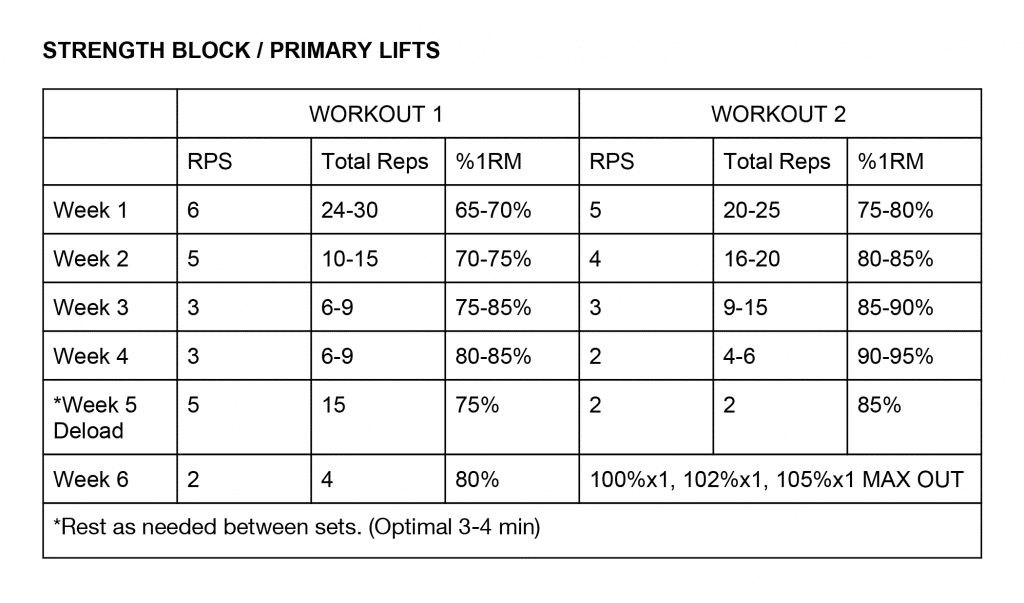
MONDAY – Sprinting / Upper Body WORKOUT 2
A. Sprinting Drills: Perform each of these 1-3 times before your sprinting work.
- A-March
- A-Skip
- Running-A
B. Sprinting Starts: Pick one of the following variations for a 10m Sprint and Perform 3-5 Sprints with 1 minute rest between them.
- Split-step start
- Push-Up Start
- 3 or 4 point start
C. Short Accelerations: Pick one of the following variations for a 20m Sprint and Perform 3-5 Sprints with 1-2 minutes rest between them. Choose a different variation than you did for B.
- Split-step start
- Push-Up Start
- 3 or 4 point start
D. Upper Body Primary Movement: Choose one movement for the duration of the training block. See “Primary Lifts Progression” for reps/sets.
- Weighted Chin-Ups
- Weighted Pull-Ups
- Barbell Rows
E. Pressing Movement – Pick one of the following and do 25-50 total reps.
- Bench Press (or DB Press)
- Incline Press (or DB Incline Press)
- Dips or Weighted Dips
- HandStand Push Ups
- Military Press (or DB Military Press
- Push Ups
F. One for the Delts – Pick one of the following for 40-60 total reps.
- DB Lateral Raise
- L-lateral Raise
- Band or Cable Lateral Raise
- DB Military Press
G. Elbow Flexors / Extensors Superset – Don’t feel like listing all the possibilities, but pick two exercises and hit 12-20 reps of each for 3 sets.
- Bicep Curls
- Tricep Extensions
TUESDAY – Jumps / Lower Body WORKOUT 1
A. Jumping Movement: Pick one of the following and do 3-5 reps for 5-8 sets. 15-30 total reps. Rest 1-3 min between sets.
- Broad Jumps
- Box Jumps
- Vertical Jump
- Plyos
- Bounding (Strides)
B. Lower Body Primary Movement: Choose one movement for the duration of the training block. See “Primary Lifts Progression” for reps/sets.
- Squats
- Box Squats
- Deadlift
C. Unilateral Quadriceps Movement: Choose one of the following for 8-12 reps for 3-4 Sets. Strong Athletes can do 5-8 reps for 3-5 sets.
- Step Ups
- Bulgarian Split Squats
- Reverse Lunge
D. Hamstrings / Posterior Chain Movement: Choose one of the following for 8-12 reps for 3-4 Sets. Strong Athletes can do 5-8 reps for 3-5 sets.
- Glute Ham Raise
- GHR Push Up + Eccentric (mega soreness)
- Swiss Ball Glute Bridge + Leg Curl
- Romanian Deadlift (mega soreness)
E. Weighted Abdominal Movement – Pick one and hit 30-40 total reps.
- Leg Raises
- Ab Wheel
- Weighted Sit-Ups
F. Gastrocnemius / Calves Movement – Pick one and hit 40-60 total reps.
- Single Leg Calf Raises
- Weighted Calf Raises
- Weighted Seated Calf Raises
WEDNESDAY – Off / Aerobic / Recovery
THURSDAY – Dynos / Upper Body WORKOUT 1
A. Dynamic Climbing Movement – Pick one of the following and perform 3-5 reps, for 15-30 total reps.
- Dyno
- Climb-Up
- Cat-Back
B. Upper Body Primary Movement: Same movement as Workout 2. See “Primary Lifts Progression” for reps/sets.
- Weighted Chin-Ups
- Weighted Pull-Ups
- Barbell Rows
C. Pressing Movement – Pick one of the following and do 25-50 total reps.
- Bench Press (or DB Press)
- Incline Press (or DB Incline Press)
- Dips or Weighted Dips
- HandStand Push Ups
- Military Press (or DB Military Press
- Push Ups
D. Horizontal Pulling Movement – Pick one of the following and do 25-50 total reps.
- DB Rows
- Band or Cable Row
- Barbell Rows
- Inverted Rows
Di. Vertical Pulling Movement (if primary movement is Barbell Rows)
- Pull Ups
- Chin Ups
- Band Assisted Chin Ups
E. Shoulder DB Complex: Perform 8-12 Reps of each exercise with as little rest as possible. Rest 1-3 min between sets. Complete 2-3 sets.
- DB Lateral Raise
- DB Rear Delt Fly
- DB Snatch + Military Half Press
F. Elbow Flexors / Extensors Superset – Don’t feel like listing all the possibilities, but pick two exercises and hit 12-20 reps of each for 3 sets.
- Bicep Curls
- Tricep Extensions
FRIDAY – Lower Body WORKOUT 2
A. Lower Body Primary Movement: Same movement as Workout 1. See “Primary Lifts Progression” for reps/sets.
- Squats
- Box Squats
- Deadlift
B. Jumping Movement: Pick one of the following and do 2-5 Reps for 3-5 Sets. 10-15 Total Reps.
- Broad Jumps
- Box Jumps
- Vertical Jump
- Plyos
- Bounding (Strides)
C. Unilateral Quadriceps Movement: Choose one of the following for 8-12 reps for 3-4 Sets. Strong Athletes can do 5-8 reps for 3-5 sets.
- Step Ups
- Bulgarian Split Squats
- Reverse Lunge
D. Hamstrings / Posterior Chain Movement: Choose one of the following for 8-12 reps for 3-4 Sets. Strong Athletes can do 5-8 reps for 3-5 sets.
- Glute Ham Raise
- GHR Push Up + Eccentric (mega soreness)
- Swiss Ball Glute Bridge + Leg Curl
- Romanian Deadlift (mega soreness)
E. Gastrocnemius / Calves Movement – Pick one and hit 40-60 total reps.
- Single Leg Calf Raises
- Weighted Calf Raises
- Weighted Seated Calf Raises
EXPLOSIVE POWER BLOCK
DISCLAIMER: Start with The FOUNDATION and STRENGTH Blocks. You should not start an explosive power training block if you haven’t been performing maximal strength and jump exercises already.

Intensity, Frequency, and Volume
The truest keys to physical performance gains are these three things. More important than how or what exercise you are performing is how hard you are making it for yourself, and how often you’re doing it.
If the movement is difficult and requires your best effort then the intensity is high. If the intensity is high the amount of repetitions you can do must be low, so the volume is low. The more frequently you can return to a movement without feeling fatigued, the more you will improve at it.
In this block you will be tasked with intense sessions 3 times per week, with a low overall volume of repetitions being performed in each session.
High Intensity, High Frequency, Low Volume.
Complex Method
When attempting to transfer strength into power you need to somehow bridge the gap between moving a barbell in the weight room and jumping from wall to wall on the street. For many athletes simply doing both in any manner of ways is enough to get results. When you train with free weights and make incremental increases in the amount of weight being moved, your body adapts to the greater load. That adaptation can take the form of muscular hypertrophy (size and density of muscles), and neural adaptation where more motor units are recruited to move the weight. We can think of a barbell squat as extending your ankles, knees, and hips against a load. Another movement that performs this task under less load is a jump.
Through only performing jump after jump your muscles and tendons will grow and develop to meet the elastic demands of the movements. The limiting factor is that your body represents a singular load. You weigh what you weigh. You could strap weights to yourself and jump, but this can change the jump technique in such a way that would be negative for improving jumping output. An example of the Complex Method is when we perform an exercise like a squat and perform it under heavy loads, after a desired rest period we perform jumps, and after yet another rest period we perform squats, and continue in this fashion.
When and how much of each should be done to get the best results? To use a cheesy parkour analogy that never really applied to the sport: there is more than one way to get from point A to B, but parkour is about finding the most efficient way.
I won’t go over all the different combinations and methods that can be used to increase your explosive power faster, but if you are interested in learning from the source, I recommend looking up anything from former Soviet Union sport scientists and coaches.
I started loosely applying the Complex Method well over 10 years ago. I was first introduced to it through reading the websites of Westside Barbell and Joe Defranco. I would often perform jumps in the weight room with peers and clients on “Speed Days”. We would lift 3-5 reps of a weight around 70% of a 1RM, take a couple minutes rest, and then perform 5 reps of a broad jump, vertical jump, or box jump.
The complex method for explosive power can be loosely described as performing a weighted exercise followed by a dynamic movement with a rest period in between the two. The rest period allows for your muscles to recover, while the immediate neural adaptation from performing the weighted movement remains and can positively affect the output of the dynamic movement. Example: Perform a barbell squat, allow muscles to recover, and perform a Jump. Just as there are various methods to combine strength and dynamic training, there are also many configurations to apply the Complex Method. The template we will be following in the Explosive Power Block is based off of one created by Yuri Verkhoshansky and published in his book Special Strength Training for Coaches. I’ve made adjustments to the basic template from my continued years of coaching and personal experience.
The Depth Jump
Depth Jumps are a key exercise we will utilize with our Complex Method in the Explosive Power Block. A depth jump is an exercise that involves an athlete dropping from a moderate height, and attacking the ground upon impact with as much jumping force as possible. Unlike a take off from place, the depth jump focuses on developing rigid elasticity. The ground contact time is crucial in making this an effective exercise. A quick attack needs to be made as soon as your feet contact the ground, however you still must jump with as much force as possible. In order to jump you need to put some bend into your knees and hips, and quickly extend by pushing through the ground. Speed must not be at the sacrifice of output, and an attempt at producing force must not slow down the elasticity of the attack. Practice of the depth jump technique is required before the program can begin. You can also expect to improve your speed and output in the depth jump movement by the end of the training block.
The jump you create after the drop can be a vertical jump, broad jump, or combination of the two. I recommend all parkour athletes to perform a vertical jump after their drop. Parkour has heavy bias on jumps that require a break at the hips to prepare for landing. A straight vertical jump allows for complete focus on extension. In a precision jump scenario the athlete extends, but then has to break at the hips to prepare a landing. The timing of this is crucial for maximum output and a safe landing. Some athletes have great training or intuition that allow them to get a very good extension before flexing in order to land. Even so, a training block that focuses on only extending (without worrying about landing on an edge) will improve the force technique of athletes that constantly cut their jump short in order to land. Basically combining Depth Jumps and Vertical Jumps will give you more bang for your buck in this training block.
More important than the type of jump performed after the drop is the appropriate set up. Targets are crucial to monitor improvement, but also for sensory feedback. See the images below for appropriate set ups for depth jumps with a broad jump and vertical jump.
The height of the drop varies depending on the athlete’s preparedness. Lower strength and power athletes should use a drop of 12” – 24” tall. Athlete’s with higher outputs and stronger legs can use a 30” to 42” tall drop. If you are unable to determine where you are at you can perform drops until you see a performance decrease. A performance decrease will present itself in one or two ways, and taking a video recording will be crucial for determining this. First, watch for a decrease in speed of ground contact as you increase the height of the drop. Second, be sure to set up a target (see above images), so that you can determine if you are having a drop-off in power output. For example: if you were touching a target with your hand on a vertical jump from a drop of 15”, but you can no longer hit this target after a drop of 18”, then 18” is too high of a drop for you.
Note: In Week 2 of the training block you will briefly increase the height of your drop. This will happen again for week’s 5 and 6. You can expect an initial drop-off in speed and jump force when you increase the drop, but this will improve by the end of the training block.
Climbing Power
I have yet to see a proper study done on complex training applied to a weighted pull-up and a dyno (maybe someday). In theory a complex method to improve your dyno or climb-up could work, but it may not have the same effect as a lower body dominant exercise.
What makes me skeptical of the efficacy of complex training for dynamic climbing comes from some personal failures, but this can be explained by the lack of increased load in the weighted movement relative to the dynamic movement. The additional load for a pull-up is quite low even for strong people. Adding 1.5-2x to your weight and performing a deadlift or a squat would stimulate a greater neural change than adding 0.25-0.5 your weight and performing a pull-up. The direction of force and range of motion for a pull-up is also completely different than that of a dyno. A weighted pull-up or chin-up is valuable still for general strength and joint health that can only come from controlled movement through a greater range of motion. For these reasons I lean more to building strength, and drilling climbing movements, separately.
Throughout this block we will increase the intensity for dynamic climbing drills and continue to perform maximal efforts with weighted pulls in separate sessions.
Schedule
Monday – Sprinting / Weighted Pulling / Jump & Squat / LTL Bounds / Abs & Calves
Tuesday – Tempo / Recovery / Light Parkour
Wednesday – Sprinting / LTL Bounds / Cat Backs / Upper & Lower Strength
Thursday – Tempo / Recovery / Light Parkour
Friday – Jump & Squat / Dyno or Climb-Up / Post Chain & Calves
Saturday – Parkour Session
Sunday – Off / Aerobic / Recovery
Parkour Sessions
Be sure to record and pay attention to all other stressors in addition to the program. You can not expect to get good results out of a plyometric program if you are doing hours of parkour the next day, running a marathon, or competing on a reality tv show. You do not need to follow this program or any other perfectly, but you do need to account for any other stressors you are putting on yourself, and make adjustments accordingly. For example: If you spontaneously have an awesome PK session the day before one of your workouts you could simply skip the workout the next day, no big deal, but don’t do both or you will likely be over-doing it. You get more powerful by recovering from training, and you recover by resting.
Due to the High Intensity of the workouts in this block I recommend you hold off from intense parkour sessions. Use inbetween days to do lighter training and drill basics that do not require a lot of jumping output. A longer jam style session can happen on Saturdays. Maximal jumps could be performed in this session, but volume should be kept very low (more incentive to stick jumps on your first try).
Primary Movements
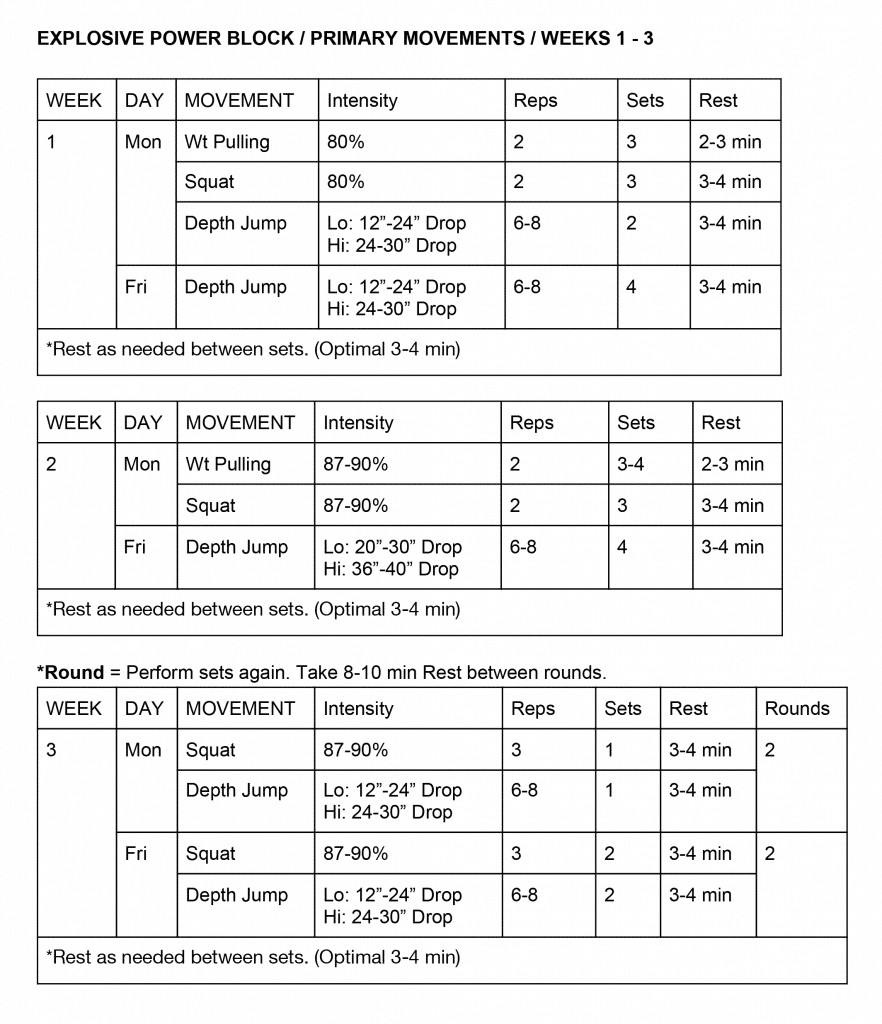
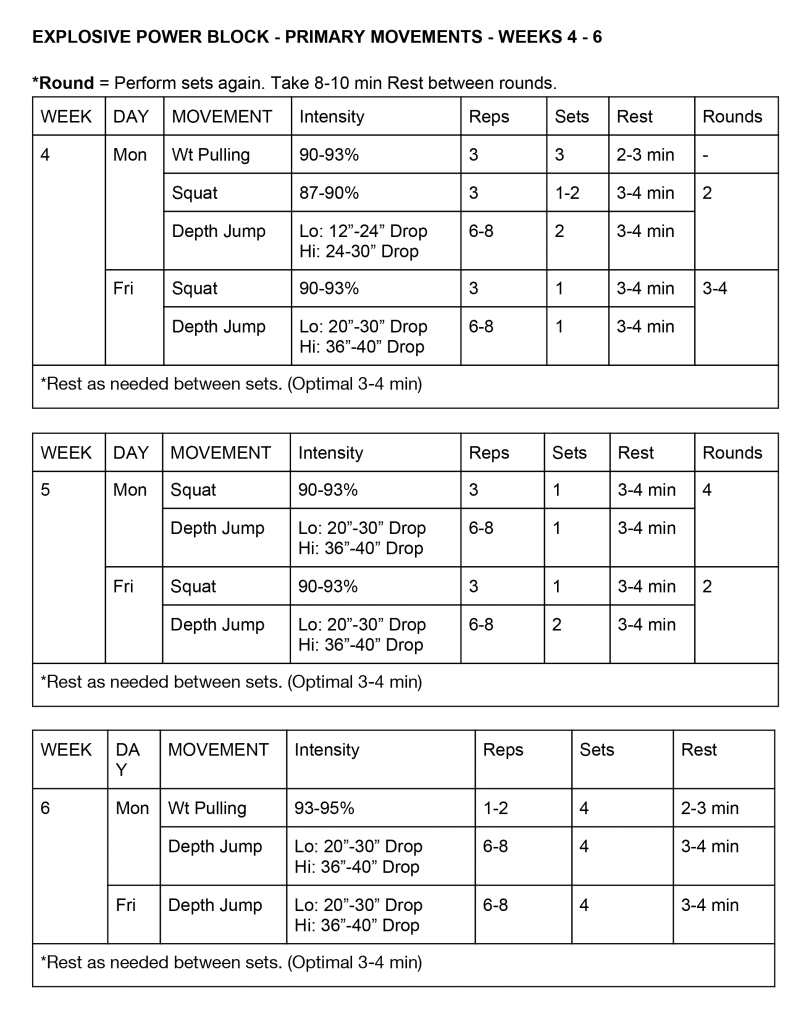
WORKOUTS
Reps/Set Ranges: I recommend performing the lower end of both your sets and reps on your first couple of weeks in order to get a feel for how much quality work you can do. After this initial feeling out period you can start to perform more volume if you feel like you are getting adequate recovery and performing quality work.
MONDAY – Sprinting, Wt Pulling, Jump & Squat
A. Sprinting Drills: Perform each of these 1-3 times before your sprinting work.
- A-March
- A-Skip
- Running-A
B. Sprinting: Easy Work Up.
- Choose a distance of 20-40m. You can build this up throughout the training block. Begin from a Split-Step Start in place. Run the first half of the distance at an easy 70% and then transition to 90% or more effort for the final half.
- Repeat this for 5-6 Sets with 1-2 minutes rest in between each sprint.
C. Leg to Leg Bounds: Start with a Broad jump from place, and perform 8-10 Alternating Leg to Leg Bounds (strides). Complete 3 Sets with 2-3 min rest between each set.
D. Weighted Pulling: Choose one movement for the duration of the training block. See “Primary Movements” Tables for reps/sets.
- Weighted Chin-Ups
- Weighted Pull-Ups
- Barbell Rows
E. Squats & Depth Jumps:
- See “Primary Movements” Tables for reps/sets.
F. Weighted Abdominal Movement – Pick one and hit 30-40 total reps.
- Leg Raises
- Ab Wheel
- Weighted Sit-Ups
G. Gastrocnemius / Calves Movement – Pick one and hit 40-60 total reps.
- Single Leg Calf Raises
- Weighted Calf Raises
- Weighted Seated Calf Raises
WEDNESDAY – Sprinting, Jumps, Strength
A. Sprinting Drills: Perform each of these 1-3 times before your sprinting work.
- A-March
- A-Skip
- Running-A
B. Sprinting: Easy Work Up.
- Choose a distance of 20-40m. You can build this up throughout the training block. Begin from a Split-Step Start in place. Run the first half of the distance at an easy 70% and then transition to 90% or more effort for the final half.
- Repeat this for 5-6 Sets with 1-2 minutes rest in between each sprint.
C. Leg to Leg Bounds: Start with a Broad jump from place, and perform 8-10 Alternating Leg to Leg Bounds (strides). Complete 3-5 Sets with 2-3 min rest between each set.
D. Sprinting: Acceleration.
- Choose a distance of 20-40m. You can build this up throughout the training block. Begin from a Split-Step Start in place.
E. Cat Backs: Pick a Difficult, but repeatable challenge, or simply practice the movement for height/distance. Perform 3-4 Sets of 3-5 Repetitions. Take 20-30 seconds between reps and 2 minutes between sets.
F. Unilateral Quadriceps Movement: Choose one of the following for 6-10 reps for 3-4 Sets.
- Step Ups
- Bulgarian Split Squats
- Reverse Lunge
G. Pressing Movement: Choose one of the following for 6-10 reps for 3-4 Sets.
- Bench Press (or DB Press)
- Incline Press (or DB Incline Press)
- Dips or Weighted Dips
- HandStand Push Ups
- Military Press (or DB Military Press)
- Push Ups
H. One for the Delts – Pick one of the following for 40-60 total reps.
- DB Lateral Raise
- L-lateral Raise
- Band or Cable Lateral Raise
- DB Military Press
I. Elbow Flexors / Extensors Superset – Pick two exercises and hit 12-20 reps of each for 3 sets.
- Bicep Curls
- Tricep Extensions
FRIDAY – Jump, Squat & Dyno
A. Squats & Depth Jumps:
See “Primary Movements” Tables for reps/sets.
B. Dynos or Climb-Ups: Pick a Difficult, but repeatable challenge, or simply practice the movement for height. Perform 3-4 Sets of 3-5 Repetitions. Take 20-30 seconds between reps and 2 minutes between sets.
C. Hip Extension: Choose one of the following for 6-10 reps for 3-4 Sets. *Note: this is not a maximum effort movement!
- KettleBell Swings or Pull Throughs
- Deadlift Variation
- Hip Thrusts
- Back Extensions
- Swiss Ball Leg Curl + Glute Bridge
D. Bodyweight Abs Circuit: Pick 3 Exercises, perform 10-20 reps or hold for 30 seconds. Repeat for 3 Sets with 1-2 min rest between sets.
- Toe Touches or Crunches
- Russian Twists or Windshield Wipers
- V-Snaps or Sit-Ups
- Plank
- Ab Wheel
E. Gastrocnemius / Calves Movement – Pick one and hit 40-60 total reps.
- Single Leg Calf Raises
- Weighted Calf Raises
- Weighted Seated Calf Raises
ON SEASON RECOMMENDATIONS
Your most notable gains will always be during a stage where you are spending most of your time specifically practicing parkour. This is where all the profound mental and technical victories are had. It’s good to get out often, crush challenges, or simply enjoy a session with friends. While you’re at it, here are some recommendations to hold on to your Off-Season gains, and stay chiseled.

General and Specialized Movements
“Maintenance” is what most on-season programs refer to when considering any exercises outside of the sport itself. Maintain your strength, maintain your fitness, maintain your cardio, etc. Maintenance is important, but just because it’s important does not mean it’s going to fire us up to get in the gym or on the field. Many variations of volume with lower weights can also make us unnecessarily sore, and restricted for parkour sessions. So instead of just maintaining let’s keep practicing and trying to improve these movements. How are we going to do that? By lowering the intensity a little, keeping the frequency or lowering it a little, and lowering the in session volume a lot.
High volume is what is most responsible for what we associate with muscle soreness and fatigue. When the focus is on building strength we sometimes need volume to stimulate adaptation, but you can still get stronger with lower volumes of work if the intensity is moderately high and you are working frequently. The tables below show examples of weekly recommendations for key movements.

I recommend just doing 1 session a week for primary lower body movements. Two sessions a week can be done for upper body pressing, because you do not use those muscles as much when practicing parkour. Upper body pulling muscles on the other hand are used a lot.

Specialized movements can and should be done more than General Movements in the On-Season. You can still make a lot of improvements during the On-Season both in the exercises and in how they affect your parkour. Short Sprint and Jump workouts can be done before or after parkour sessions or on the same day you do strength exercises.

Below is one example of what an On-Season Week could look like.
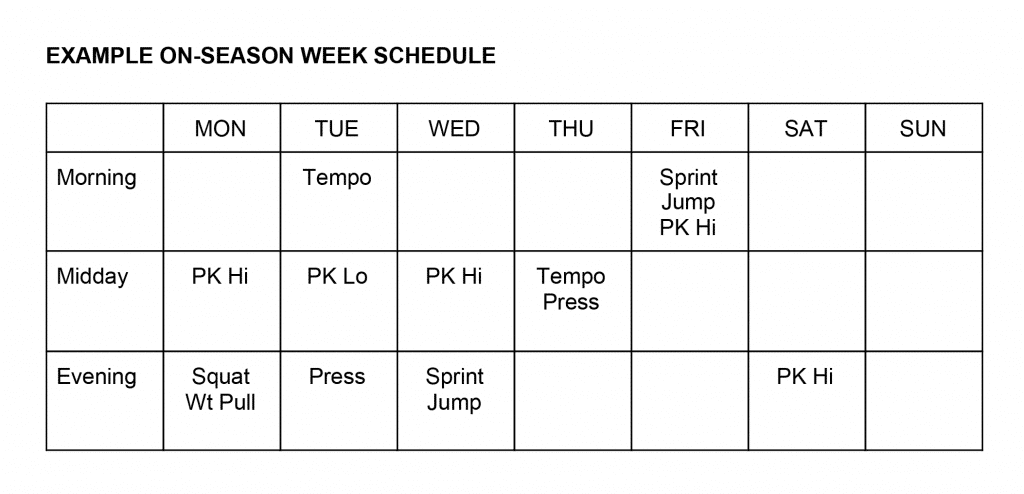
Accessory Exercises
You should continue with some accessory exercises during the on-season, but try to limit the intensity. A great time to do accessory work is during tempo workouts and warm-ups. (See Foundation block for example tempo workouts.) During the On-Season you should still try to get in two tempo sessions a week for enhanced recovery.



